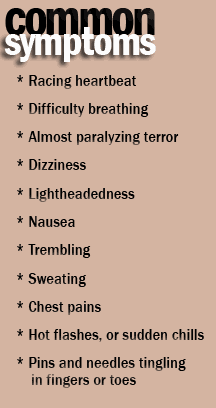 Begin Solving the Panic Problem
Begin Solving the Panic Problem
The first time it happened to you, you probably didn’t know what to call it or what was really happening. Perhaps you felt so afraid, you actually believed you might die, or faint, or go crazy.
Or that maybe those around you would think you’re crazy. After all, the symptoms of a panic attack often happen with no warning and no clear reason. This unpredictability makes for more fear.
If things get worse, you might begin to feel your only defense is to stay at home, and avoid people and places that used to be a normal part of your life. You find your world getting smaller while the fear keeps growing. (Learn the facts about panic disorder.)
Don’t be Conned by Panic
The fear you feel is real, and anyone who says it isn’t hasn’t been in your shoes. But the danger that the fear represents isn’t real. Panic attacks don’t cause death, fainting, or insanity. So when you respond to a panic attack the way you might respond to real danger – for example by fleeing or avoiding situations or places – it doesn’t work since there is no real danger.
Instead, your effort and energy actually fuel the symptoms of panic and make things worse. Which leads to another panic attack. And that’s the con of panic. That’s the way it invades and tries to dominate a person’s life.
Take Back Your Life
Studies show that persons with panic disorders can and do live normal, satisfying lives. But treatment is key.
I work with people to solve the panic problem by teaching them new ways to watch and think clearly and accurately about what is happening in their body, mind and feelings. With support, patience and practice, they learn the best ways to think and act whenever panic symptoms arise.
By making changes in thinking and behavior, you can learn to overcome fearful panic attacks. If you like, learn more about panic disorder. Or read on about how I can help.
How I Work & What You Can Expect
I start by helping you understand exactly what panic disorder is. You learn how the cycle of panic happens. You learn that you and your feelings, even fear, aren’t the problem…it’s the way you may be responding to panic that is the problem. Certain behaviors, fueled by extreme and unrealistic thoughts, actually make the panic attack worse. We’ll work on ways you can change those behaviors.
We’ll also work on your ability to stop avoiding situations, places, and people that you feel may bring on an attack. One way I do this is by breaking a fearful situation down into small manageable steps and helping you do these steps one at a time until the most difficult level is mastered.
I also teach relaxation and other techniques to help you avoid or get through an attack. Some experts have found that people with panic disorder tend to have slightly higher than average breathing rates. Learning to slow this can help you deal with a panic attack and can also prevent future attacks.
Evidence Supports the Effectiveness of CBT
The methods I use are not original. They are based on a respected form of therapy called Cognitive Behavioral Therapy. CBT for panic disorder has been well established as an effective treatment. To date, 25 controlled trials exist supporting its efficacy. CBT is endorsed as a first-line treatment for panic disorder in consensus treatment guidelines developed by the National Institute of Mental Health and the American Psychiatric Association.
Start By Calling
Schedule a free consultation with me at (805) 648-2805, or contact us via this website. My office at Main Street Counseling Group is in Ventura, Calif., and you can learn more about me on this website. I look forward to helping you solve the panic problem!
